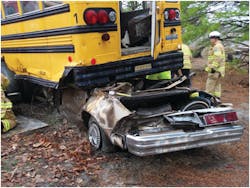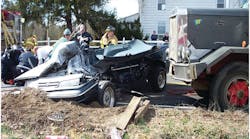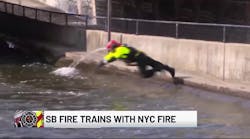We continue our discussion in the area of heavy commercial vehicle extrications with a focus on decisions that need to be made on the emergency scene, and what type of resources will be needed to mitigate the incident. As we noted last time in our discussions, dealing with these large road haulers will tax the capabilities of even the best rescue companies; it is of paramount concern that rescuers respect the potential for considerable long-term operations and multiple-action areas within the inner scene circle.
First, upon receiving a dispatch to an extrication that involves a large commercial vehicle, be sure that the right resources are responding as soon as possible. Many companies utilize an automatic aid system that will provide for notification and dispatch of multiple heavy-duty rescue companies to the incident. Considering the potential for multiple injuries and significant entrapment issues, it is wise to get the troops on the road immediately; they can always be sent back if they are not needed. Be sure to make contact with a response-capable heavy wrecker company; in the event of an under-ride or rollover incident involving passenger vehicles and commercial vehicles, a heavy-duty wrecker with a rotating boom assembly would prove to be advantageous on the scene. Coordinate these resources with local law enforcement, as many police departments have these resources categorized and “on standby” to respond to major roadways in your response area. Be sure to notify them immediately upon arrival if you think that their services might be needed (photo 1).
There will be significant potential for an increased hazardous-material release risk. Most times, when dealing with passenger vehicle extrications, the fuel system will remain somewhat intact; there may be a leaking fuel line, but for the most part it will be able to be controlled with minimal additional resources. Commercial trucks, however, pose a larger risk. Notwithstanding the materials that are being transported, most large tractor trailers can carry upwards of 300 gallons of fuel in dual saddle tanks directly under the cab. Not only is this a potential combustibility issue, but unless the material is contained and diverted, patient access may require your rescuers to work directly over the product when it is released onto the roadway. Have the resources needed to handle this issue quickly so the extrication can be set into action.
Operational Considerations
Upon arrival, after scene safety has been secured, there is one critical question that has to be answered: Where is/are the victim(s)? The victim location will define what type of operation will be needed (lift, move, swing, drag, etc…) and what additional resources are going to be needed. In the event the victim is in the cab of the commercial vehicle, consider this: your rescuers will be working above ground level. Where will they operate from? You do not want your members operating from the thin metal step treads that are mounted on the vehicles’ fuel tanks; this is a recipe for definitive injuries to your staff (photo 2).
Working with the equipment on the responding apparatus, many rescue companies will have to set crib stacks and ladders for makeshift “scaffolds” just for crews to work from. Instead, think about requesting a flatbed car carrier to the scene; this would serve as a sturdy platform for the rescue crews to work from. Secondly, stabilization needs will be difficult. Frame rails for commercial vehicles are much higher than what are found on passenger vehicles. Larger-sized cribbing may be needed, not only for an increase in weight support, but to provide for height gain in our crib stacks. Furthermore, when it comes to cribbing these vehicles, the cab of the truck will need additional cribbing from the frame rails to the underside of the cab (photo 3). These vehicles not only have body-mount assemblies, but many of these are spring-loaded or pneumatically charged to adjust the ride for the operator. The cab “load” will also have to be directed to the ground through the frame rails.
Keep in mind that many of the heavy truck cab’s components are considerably heavier than what you may find in a passenger vehicle. These components will have to be fatigued, removed and lowered safely once they are displaced. Consider what will happen after the victims have been disentangled and have been packaged for removal; your crews will be used to lifting the victims out of their cars. In these cases, your crews will be accepting the victim over their heads, and will have to lower them onto a stretcher. The mere act of removing a somewhat larger victim will require a significant amount of manpower. Have the adequate personnel on scene and ready to receive the victim once they have been packaged.
Once we have identified the victim location and the plan to remove them, we need to consider the next point: Is there a need to displace or move the vehicle(s)? When we have to lift or move a vehicle (think under-ride or over-ride with a passenger car), we need to know the weight of what we will be moving. One quick way to get a rough idea of the potential weight of the vehicle involves counting the axles and adding the weight ratings together (photo 4). A good rule of thumb for axle weight is:
Steering axles with thin profile tires = 12,000 pounds/axle weight rating
Steering axles with wide profile (flotation) tires = 25,000 pounds/axle weight rating
Drive axles on tractor/truck = 20,000 pounds/axle weight rating
Tag axles/trailer axles = 15,000 pounds/axle weight rating (Note: this is an averaged assumption; some may be rated for more, but it will get you started.)
Taking the above numbers into consideration, we can add the Gross Vehicle Weight Rating (GVWR) for a vehicle. For example, consider a twin-drive axle dump truck, equipped with a tag axle and wide profile tires on the steering axle. Based on the estimations above, the potential capacity of that truck and contents can weigh around 80,000 pounds. What do you have in your resource caches that can lift/move/haul/hold these loads? Finding an answer to this question at the scene is not a good plan.
Don’t forget about the properties of the cargo; solids, liquids and gases all react differently when they are displaced, and some of them can provide enough inertia to cause vehicle displacement in an adverse direction (photo 5). Some container trucks must be off-loaded prior to lifting; be sure to check with the experts before trying something that may end in disaster.
Displacement and separation may be as simple as wrapping the vehicles’ suspension systems with chains and load/ratchet binders. Many rescue companies have opted to carry large flat-load straps on their rigs. These straps can be deployed much easier than grade 80 chains can, and are not as bulky to work with. These straps will have hooks and connection points on them to be utilized on frame rails, rims, suspension parts, etc… Wrapping the suspension systems tight will result in 5 to 6 inches of displacement in passenger vehicles, and up to 12 inches when lifting larger vehicles off of passenger cars (photo 6). When the suspensions are under compression, it may provide an adequate amount of displacement to separate the vehicles so that disentanglement procedures can begin. If not, then the larger vehicle will most likely need to be lifted or displaced from the smaller vehicle. If this is the case, you will need cribbing and associated strut supporting equipment that is strong enough to handle the working load limit of the vehicle. A combination of resources may have to be utilized in order to lift the larger vehicle. For example, a heavy-duty wrecker may provide the strength to raise the larger vehicle high enough to separate the vehicles, but will benefit from cribbing and support from the underside of the vehicle, if possible.
Once the lift is done, it may be necessary to separate the vehicle(s) and begin the extrication. This may require dragging the passenger vehicle back from underneath the commercial vehicle (photo 7). While I understand that this approach is a bit controversial, and this may raise an eyebrow (or considerably more) on a few rescuers, let’s consider two very critical points to this argument:
1. It is not recommended to be working underneath any suspended load. If your resources on scene cannot only lift, but stabilize the load in such a way that your crews will be protected while they work on the smaller vehicle, then go right ahead and begin patient care. However, it has been my experience that is not possible very often (if at all).
2. If your rescuers cannot access the patient, then they cannot provide patient care. Having discussed this position with a few trauma physicians, most of them echo a common fact about patient care; they can fix a lot of things on a person, but they can’t fix dead. That not only stands to reason for the patient, but for the rescuer as well.
Remember this point: it may not be necessary to move the vehicle the patient is in. For example, it may just be a question of uprighting a commercial vehicle that has come to rest on top of a car. Once that occurs, patient care can happen immediately. Do not operate with “functional fixation;” these incidents will require some detailed analysis and thought to come up with a solution, so be flexible.
Conclusion
Extrication scenes can be stressful, fast-paced, and tedious at the same time. Throw a large commercial vehicle into the fray and the scene now has added potential kinetic energy hazards, hazardous material control, lifting and moving issues, and considerable reactive forces at work during the incident. Make it a point to include a commercial vehicle into your next extrication training session; even if your rescuers do not cut or spread it, just working on moving it will require some considerable effort. Don’t let your next lesson in this field be in the middle of the highway.
Until next time, stay focused and stay safe.
MICHAEL P. DALEY is a lieutenant and training officer with the Monroe Township, NJ, Fire District No. 3, and is an instructor with the Middlesex County Fire Academy, where he is responsible for rescue training curriculum development. Mike has an extensive background in fire service operations and holds degrees in business management and public safety administration. Mike serves as a rescue officer with the New Jersey Urban Search and Rescue Task Force 1 and is a managing member for Fire Service Performance Concepts, a consultant group that provides assistance and support to fire departments with their training programs and course development. Mike has been guest on several Firehouse.com podcasts including: Successful Rescue Operations in Today's Fire Service, Preparing for Tomorrow's RIT Deployment Today and Basement Fire Tactics Roundtable podcasts. View all of Michael's articles and podcasts here. You can reach Michael by e-mail at: [email protected].







